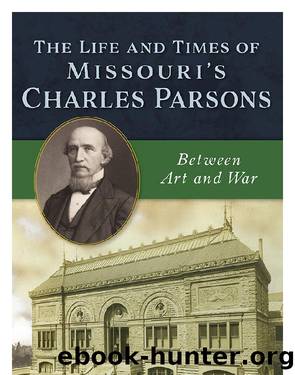The Life and Times of Missouri's Charles Parsons by Launius John;

Author:Launius, John;
Language: eng
Format: epub
Publisher: Arcadia Publishing Inc.
Published: 2020-08-15T00:00:00+00:00
Sanford Robinson Gifford (American, 1823â1880), Rheinstein, 1872â74. Oil on canvas, 31â x 27¼ in. Mildred Lane Kemper Art Museum, Washington University in St. Louis. Bequest of Charles Parsons, 1905. WU 2182.
Jules Breton (1827â1906) was another painter with whom Parsons corresponded and perhaps met in person on his numerous trips to Europe, beginning in the late 1850s. Breton was a naturalist whose mastery was recognized in his ability to convey the power and beauty of idyllic, pastoral scenes of his native northern France.369 Following the publication of Strahanâs Art Treasures of America, Parsons sought to add a Breton to his collection and sent a letter to the artist. Breton responded in French in a letter dated April 1881, from his hometown of Courrières, translated here:
Sir,
I am so very flattered that you are manifesting this desire to own one of my
paintings and at the same time I really wish to please you and it will be a
joy to create it for you.
When could I possibly do it! There is the ultimate question. I am already late with my other customers who do not appreciate my work as you do.
All I can do at this time is to take some good notes of what you wish for me to create for you. I will create it when I have time.
In the meantime, I am praying that you please accept my sentiment here for your good words that describe your acknowledgment.
I wish you the highest of praise.
Jules Breton370
Breton was a prolific artist and was probably telling the truth to Parsons regarding his schedule, but this letter may have been an attempt by Breton to raise the price of the commission if Parsons wanted it sooner. It seems as though Parsons was unsuccessful in purchasing a new painting and settled for a work from 1858, entitled Le Lundi (Mondays).371 In another letter to Breton, Parsons pressed the artist to provide âdetails of the charactersâ displayed in the painting, although Bretonâs response has not survived.372
Charles Parsonsâs collection of paintings was among the best private collections of its time in the United States, recognized as including works of âhigh technical quality carefully composed and finely executed.â373 Parsons truly loved art in all its expressions, and his collecting tastes demonstrated that he was educated in the arts and aware of the most modern and popular collecting trends.374 He was not merely collecting to demonstrate the mid-nineteenth-century sentiment that art ownership demonstrated âpower and superiority.â375 Charles Parsons was genuinely moved and inspired by having the means to surround himself with objects of art and dedicated nearly thirty years of his life to contributing to the education of students who would go on, in many cases, to inspire a nation with their creations. To the general public, he dedicated his time and resources to create a central repository, the first museum west of the Mississippi, for all to enjoy.
Download
This site does not store any files on its server. We only index and link to content provided by other sites. Please contact the content providers to delete copyright contents if any and email us, we'll remove relevant links or contents immediately.
How to Be a Bawse: A Guide to Conquering Life by Lilly Singh(6725)
Spare by Prince Harry The Duke of Sussex(4247)
Millionaire: The Philanderer, Gambler, and Duelist Who Invented Modern Finance by Janet Gleeson(3599)
Harry Potter 02 & The Chamber Of Secrets (Illustrated) by J.K. Rowling(3301)
Urban Outlaw by Magnus Walker(2961)
The Heroin Diaries by Nikki Sixx(2949)
Never by Ken Follett(2941)
Japanese Design by Patricia J. Graham(2576)
The Club by A.L. Brooks(2402)
Machine Learning at Scale with H2O by Gregory Keys | David Whiting(2349)
The Man Who Died Twice by Richard Osman(2327)
Stacked Decks by The Rotenberg Collection(2297)
Harry Potter and the Deathly Hallows (7) by J.K. Rowling(2244)
Harry Potter and the Prisoner of Azkaban (Book 3) by J. K. Rowling(2147)
Fairy Tale by Stephen King(2124)
Will by Will Smith(2098)
Churchill by Paul Johnson(2025)
The Chimp Paradox by Peters Dr Steve(1880)
The 7 Habits of Highly Effective People: Powerful Lessons in Personal Change (25th Anniversary Edition) by Covey Stephen R(1849)
